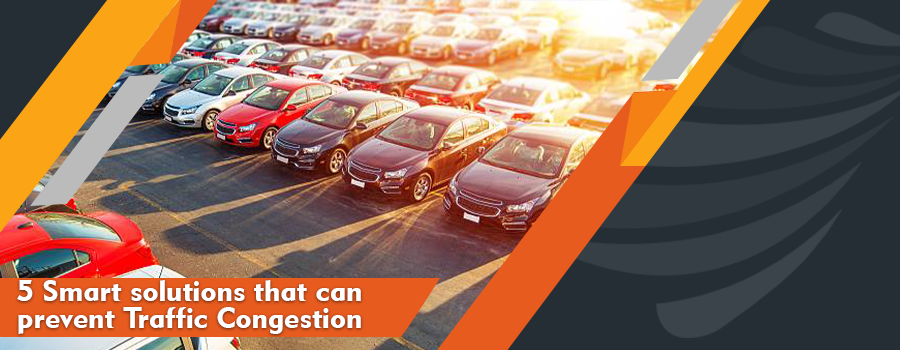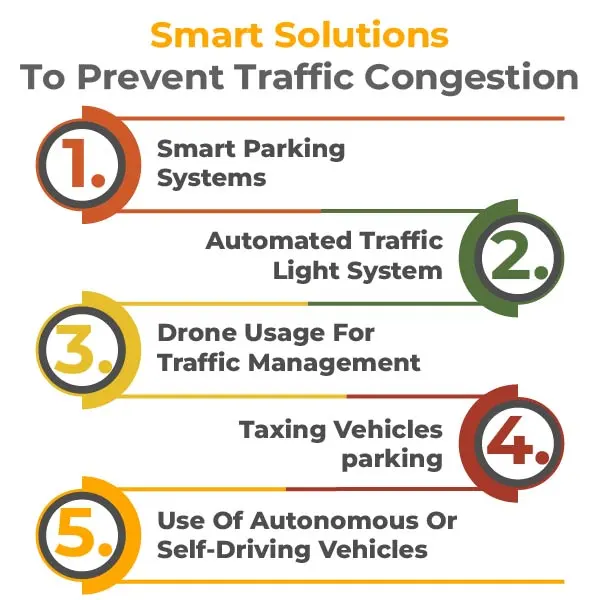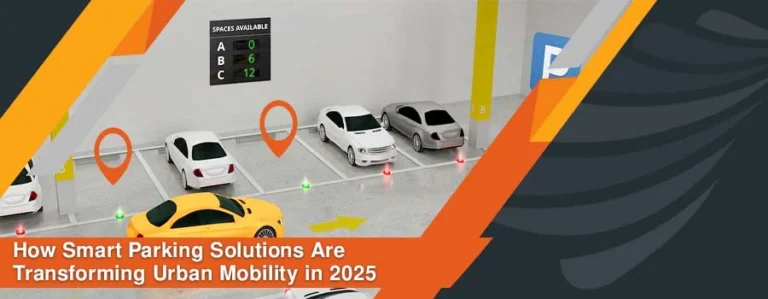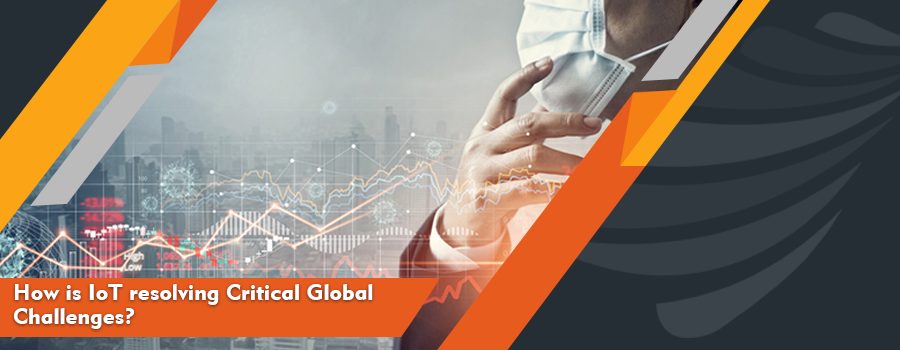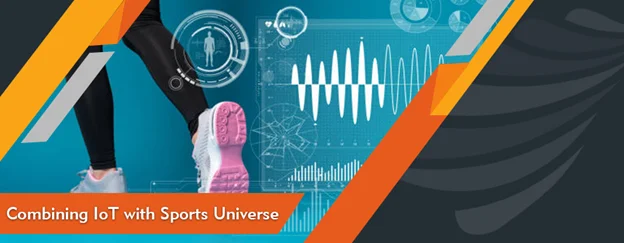Given the astonishing rate of technological advancement, the world is now becoming a better and smarter place. Almost every domain in the world is becoming influenced by IoT solutions and AI devices. Thus, traditional cities are transforming into smart cities to raise the standard of living. The smart city refers to the urban development where mechanical objects or devices are connected with the help of IoT. Through such innovation, the administration can run, monitor, and manage traffic and transport, energy production, water supply, and waste disposal easily and systematically, without negatively affecting the environment.
However, certain factors and issues still act as barriers to the completion of a smart city, among which is traffic congestion. It is a crucial issue that needs to be addressed to achieve the vision of a smart city.
Causes and Effects of Traffic Jams
There are several reasons for traffic congestion and jams in a city. First and foremost is the increasing rate of population growth and urbanization. Since the population and urban centers are being built, there has been a consistent rise in the need for private vehicles. Though the automotive industry’s production and sale are fabulous, the streets, avenues, and roads are getting crowded. This can worsen when the city’s administration follows old or traditional traffic management methods. It is pertinent that these methods are bound to fall and will not cater to the needs of the increased population of today’s time. Moreover, traffic congestion can also be evident when there are constructions on the road or inclement weather conditions. Therefore, disruption of traffic mobility burdens the operation of other sectors in the city, causing a chaotic atmosphere in the city.
Traffic jams have severe effects on the city’s management. It can burden the occurrence of multiple economic activities in the city. For instance, it could lead to opportunity costs. This means, at the microeconomic level, a person’s time gets wasted in traffic congestion that could have been utilized for incurring benefits. Furthermore, huge traffic jams ruin the condition of vehicles. Consistent brake and acceleration can force the riders to early vehicle maintenance. Plus, waiting in the traffic while the engine is running does not only increase your fuel consumption/ wastage but also has adverse effects on the environmental footprint. Traffic jams become a flashpoint for emitting huge amounts of carbon or other harmful gases into our precious atmosphere.
Hence, traffic congestion is among the major barriers to the smart city concept. Fortunately, with the advancement in the IT sector, we can enhance traffic management and operations. Owing to different IoT-based devices, systems, and smart solutions, the conditions of traffic jams can be prevented easily and efficiently. Below are five smart solutions that can help prevent traffic congestion.
Smart Solutions To Prevent Traffic Congestion
1. Smart Parking Systems
The cities must adopt smart parking systems to counter and prevent traffic congestion. The traditional parking method can cause irregular vehicle parking that reduces the parking space in an area. This can cause traffic jams, as the driver takes a lot of time finding a parking spot. However, IoT in transportation has revolutionized the whole method of car parking. For example, ParkSmart is a smart parking solution through which drivers can find an empty parking spot on their smartphones through a specialized app. It also provides real-time notifications or alerts and the closest route to the driver about its location. Such IoT innovations are beneficial in countering traffic congestion, as they truly contribute and add value to the concept of a smart city.
2. Automated Traffic Light System
Another smart way through which traffic jams can be prevented is an automated traffic light system. With IoT in transportation, the working of traffic light systems can be enhanced. With data-driven features, traffic signals can be made adaptive and automated. This will help to regulate the traffic more conveniently and prevent road blockages. Also, smart programming can increase the response time of traffic signals. It will make them smart enough to respond appropriately to the movement of vehicles of different sizes while maximizing the road capacity. This will significantly reduce the delays of running engines at traffic signals, minimizing the harmful environmental effects.
3. Drone Usage For Traffic Management
Thirdly, traffic management can also be improved through smart IoT-based drone usage. It is one of the innovative ideas through which the administration or city officials can carry out multiple tasks like inspection or repair through smart drones. Though an adaptive traffic light system and optimized signals can do the job, we can further use drones for more efficient handling of the situation. This will reduce the number of extra trucks or vehicles on the roads, specifically during rush hours. Moreover, pedestrian traffic also adds huge volume to the congestion, if left unmonitored. With the help of such IoT innovations and gathering different data, we can easily and smartly adjust pedestrian traffic and reroute vehicle congestion seamlessly.
4. Taxing Vehicles parking
The growth in population and urbanization may have some cons in disguise that may lead to traffic congestion. It has become an urban cult in that every person likes to own a private vehicle and travel to work through it. A huge segment of the masses mostly avoids public transport systems and prefers to travel privately. In addition, most enterprises and private companies give incentives to their employees by not taxing them for parking fees. This encourages the workers to come in separate cars, which significantly affects congestion and pollution. Thus, levying some parking fees at workplaces can benefit utilizing public transport to work. As a result, this will even encourage employees to carpool to the company. It will further reduce the possibilities of traffic congestion and prevent harmful effects on the environmental footprint.
5. Use Of Autonomous Or Self-Driving Vehicles
Utilizing self-driven cars can reduce traffic congestion to some level. Generally, traffic congestion is caused by human error, road rage, and the desire to reach early at someplace. This causes drivers to take shortcuts, wrong turns, or even commit haste changing of lanes. This may lead to long traffic jams and accidents. Thus, with the help of autonomous cars and vehicles, traffic management can become easy, civilized, and organized. It will reduce human intervention, and traffic rules will be followed effectively. This further help the person reach the destination on time with the best route available. Such technological advancements can also help find empty parking spots, lessening drivers’ major worries. All such IoT innovations in the form of autonomous vehicles can significantly reduce traffic congestion and the ratio of road accidents. Plus, this will eventually improve the safety of passengers, drivers, and pedestrians, which is one of a smart city’s main and basic principles.
To Sum up…
In a nutshell, IoT in transportation, such as smart parking systems or self-driven vehicles, can revolutionize the traffic management system. Likewise, through other aforementioned innovative and smart solutions, the city administration can effortlessly reduce the possibility of traffic jams and increase the road capacity, especially during peak hours. This will, in turn, add greater value to an eco-friendly environment and smooth transformation into a smart city.

